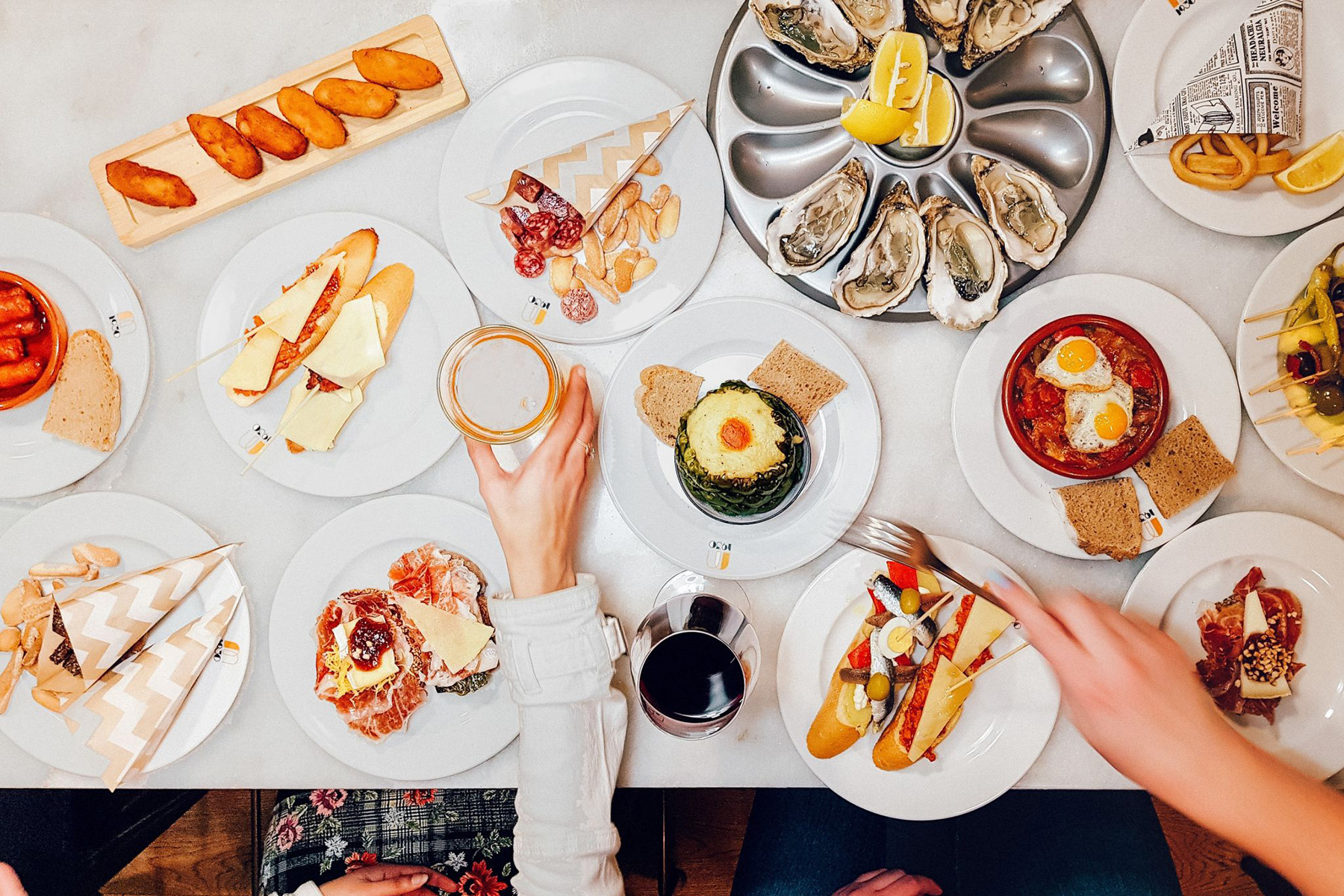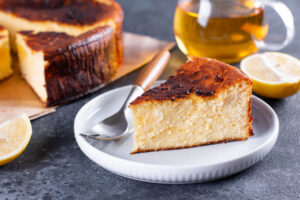It is commonly said that Spanish cuisine pleases the most demanding palates all over the world. After all, la cocina española is famous for its distinctive flavors, wonderful aromas, intense colors, and centuries-old recipes.
Furthermore, the country’s most prominent chefs, including Juan Mari Arzak, Ferran Adrià, Pedro Subijana, and Martín Berasategui, have set new trends in the contemporary culinary world. According to the latest ranking of The World’s 50 Best Restaurants, three out of the top 10 restaurants are in Spain.
They say that food in Spain is much more than just a meal. Rather, it is a source of pride, a way to live, and is central to the country’s identity. The diversity and richness of Spanish cuisine also reflect the history of the country and its intricate mosaic of cultures.
Navigate through the diverse landscape of Spanish cuisine by reading the following sections:
HelloFresh
Want to create some classic Spanish dishes in your own kitchen? HelloFresh is a leading meal-kit provider that delivers innovative recipes from Spain and around the world straight to your doorstep. Choose from a range of recipes and let HelloFresh transform mealtime for you and your family.
An overview of Spanish cuisine
In its long history, Spain has served as a crossroads for diverse civilizations, cultures, and ethnic groups. Ancient Greeks and Romans, Moors, and Jews have all had an impact on many aspects of Spanish culture, including its cuisine. For instance, it is believed that the Phoenicians brought the olive tree to the Iberian Peninsula. The Moors introduced sugarcane, rice, almonds, vegetables, fruits, and a wide variety of herbs and spices; including aniseed, cumin, mint, coriander, cinnamon, nutmeg, and saffron.
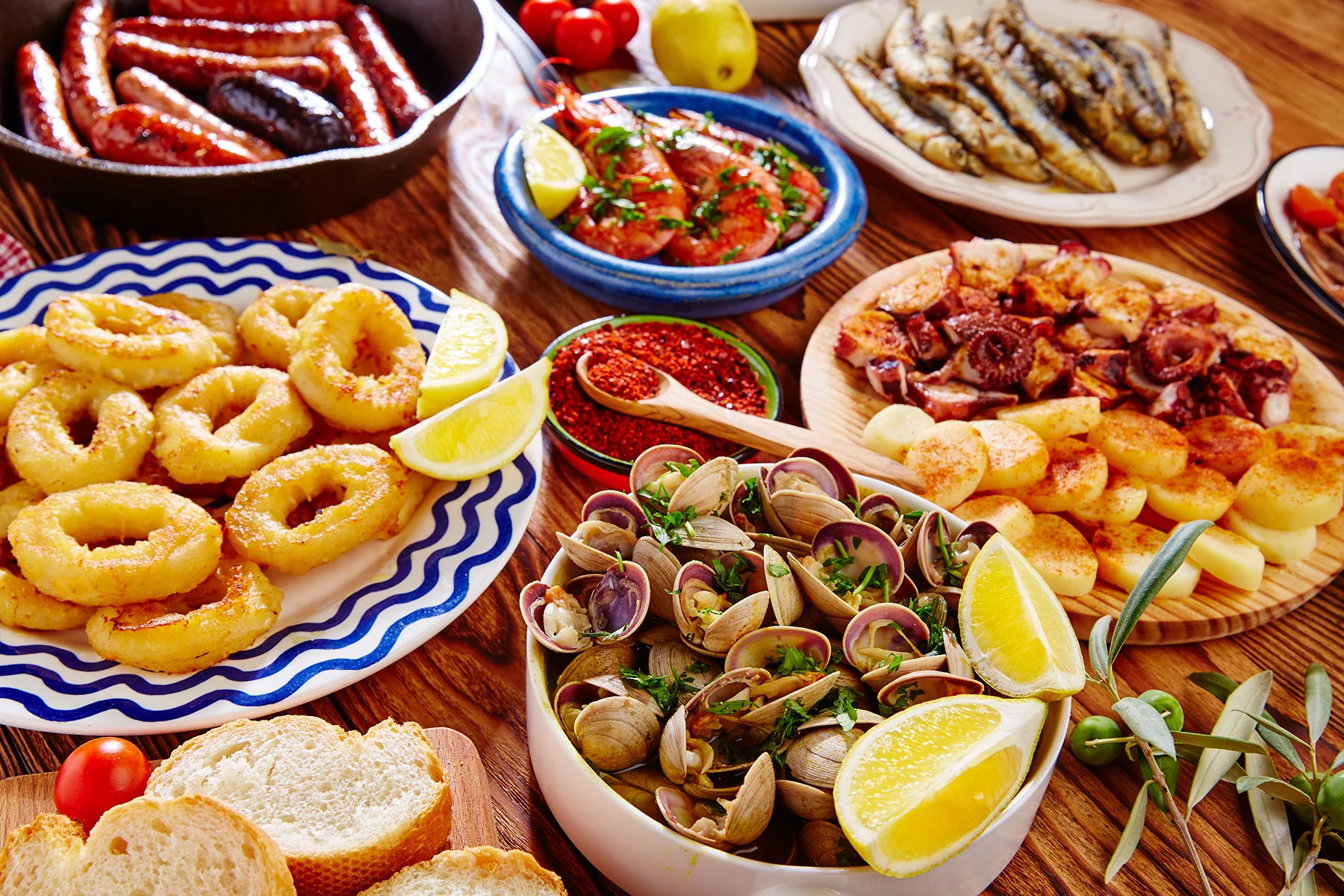
Spanish explorers of the New World brought new food items to Europe from the Americas; such as tomatoes, potatoes, corn, cacao, vanilla, chili peppers. Of course, all these products were later incorporated into Spanish cuisine. Spanish gastronomy also embodies influences from other countries such as France, Italy, England, and also Northern Africa. As a result, you can find exquisite food delicacies throughout the whole of Spain. Furthermore, each of the 17 autonomous communities (Comunidades Autónomas) has its own local specialties, signature dishes, and cooking techniques.
The Spanish diet
Traditional Spanish cuisine is one of the most prominent representatives of the balanced and varied Mediterranean diet which belongs to the countries bordering the Mediterranean Sea. Interestingly, UNESCO even acknowledged the Mediterranean diet as an intangible cultural heritage in 2010. The diet is based on seasonal, locally grown foods that are unprocessed or minimally processed.
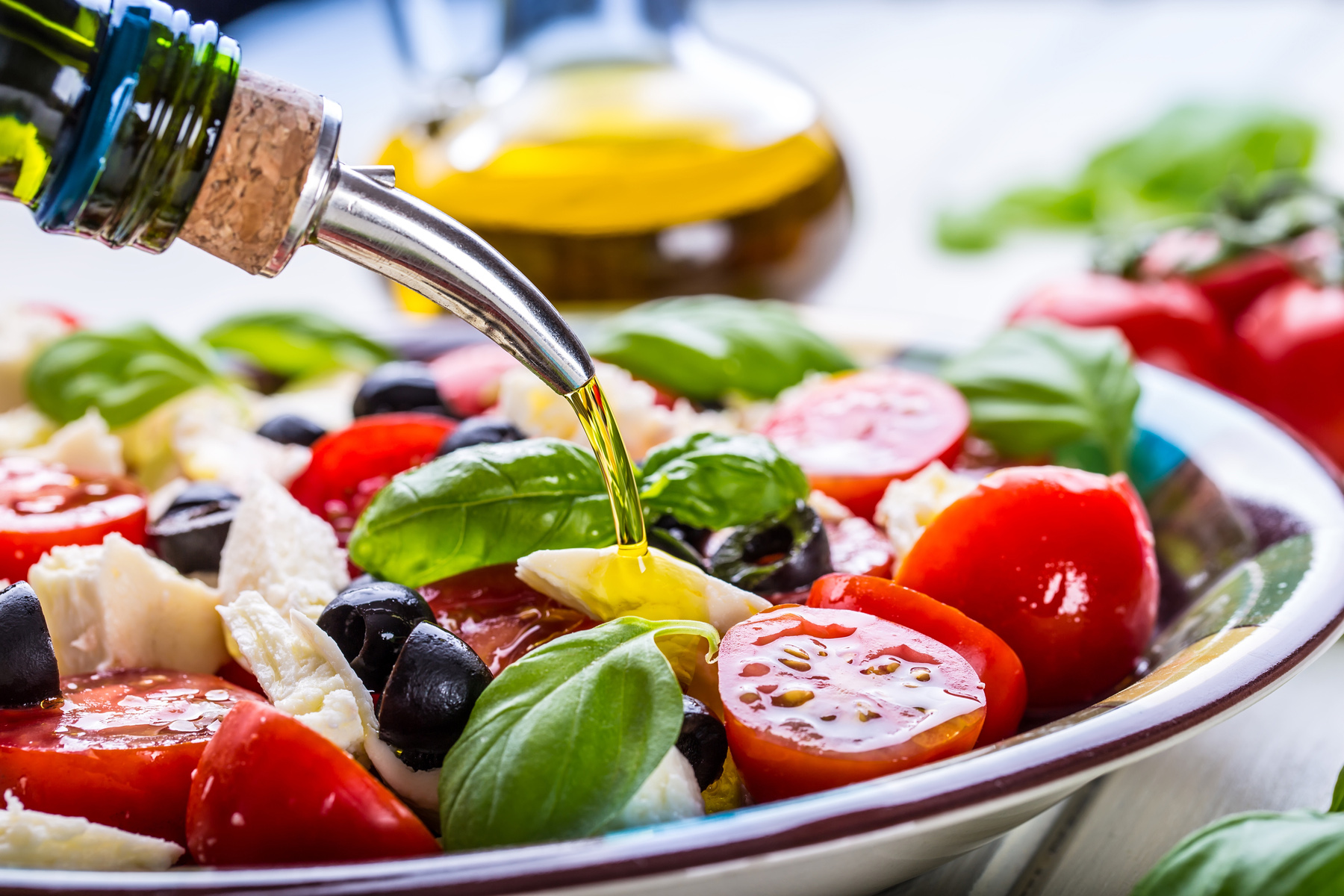
Therefore, the typical components of the Mediterranean diet are plant foods (fruits, vegetables, cereals, legumes, tree nuts, olives, and seeds) and olive oil. The Spanish diet includes moderate consumption of fish and seafood, dairy products (yogurt, cheese), poultry, eggs, and a moderate intake of alcohol (wine during meals). It is also low in red meat, processed meat, and refined sugars.
The Spanish diet is appreciated for its health benefits, which contribute greatly to the overall health of the nation. According to the World Bank, Spain’s average life expectancy is ranked as one of the highest in the world at 82 years as of 2020. Furthermore, the 2019 edition of Bloomsberg’s Healthiest Country Index ranks Spain as the healthiest nation in the world. Researchers suggest that the exceptional health of Spaniards is largely due to their eating habits which are based on the Mediterranean diet.
Mealtimes in Spain
The Spanish rhythm of life is set around the meal schedule. Although Spaniards have a reputation for being laid-back, they keep their meals on a tight schedule in their everyday life. They love spending time eating together, and their after-meal discussions over a cup of coffee can last from 15 minutes to hours. In fact, these even have their own word in Spanish – sobremesa, which literally means “over the table”. This concept illustrates the Spanish attitude towards life which is all about socializing, with no rush. The Spanish meal schedule usually includes the following:
Breakfast in Spain
Spaniards begin the day with a light breakfast (el desayuno) before leaving for work or school. This usually includes a hot cup of coffee paired with a croissant, bollos (sweet rolls) with jam, or sweet pastry such as churros (Spanish doughnuts). Toast or bread are also common. Orange juice, hot chocolate, or coffee with milk are other popular breakfast drinks.
Lunch in Spain
The most important meal of the day for Spaniards is la comida (lunch). It features multiple courses such as a salad, soup, meat or fish, and a dessert. The menu is quite substantial and varied.

The afternoon snack time in Spain
The afternoon snack time has its own word in Spanish – la merienda. This might include yogurt, desserts (pastries or churros with chocolate), fruits, or more substantial foods such as bocadillo (a sandwich) with ham, cheese, or chorizo (sausage).
Dinner in Spain
In Spain, dinner (la cena) is a lighter meal than lunch. Therefore, the portions are smaller and the items are simpler. Dinner can consist of a salad, omelette (tortilla), portion of cured ham, cheese, or sausage.
Snacks in Spain
Tapas is an iconic part of Spanish cuisine that not only reflects Spanish eating customs but also the Spanish spirit and way of life. As Rafael Ansón, President of the Spanish Royal Academy of Gastronomy, explains, “Tapas is a style of eating. It’s not just what you eat, it’s how you pick it up and the way you share the tapas experience”.
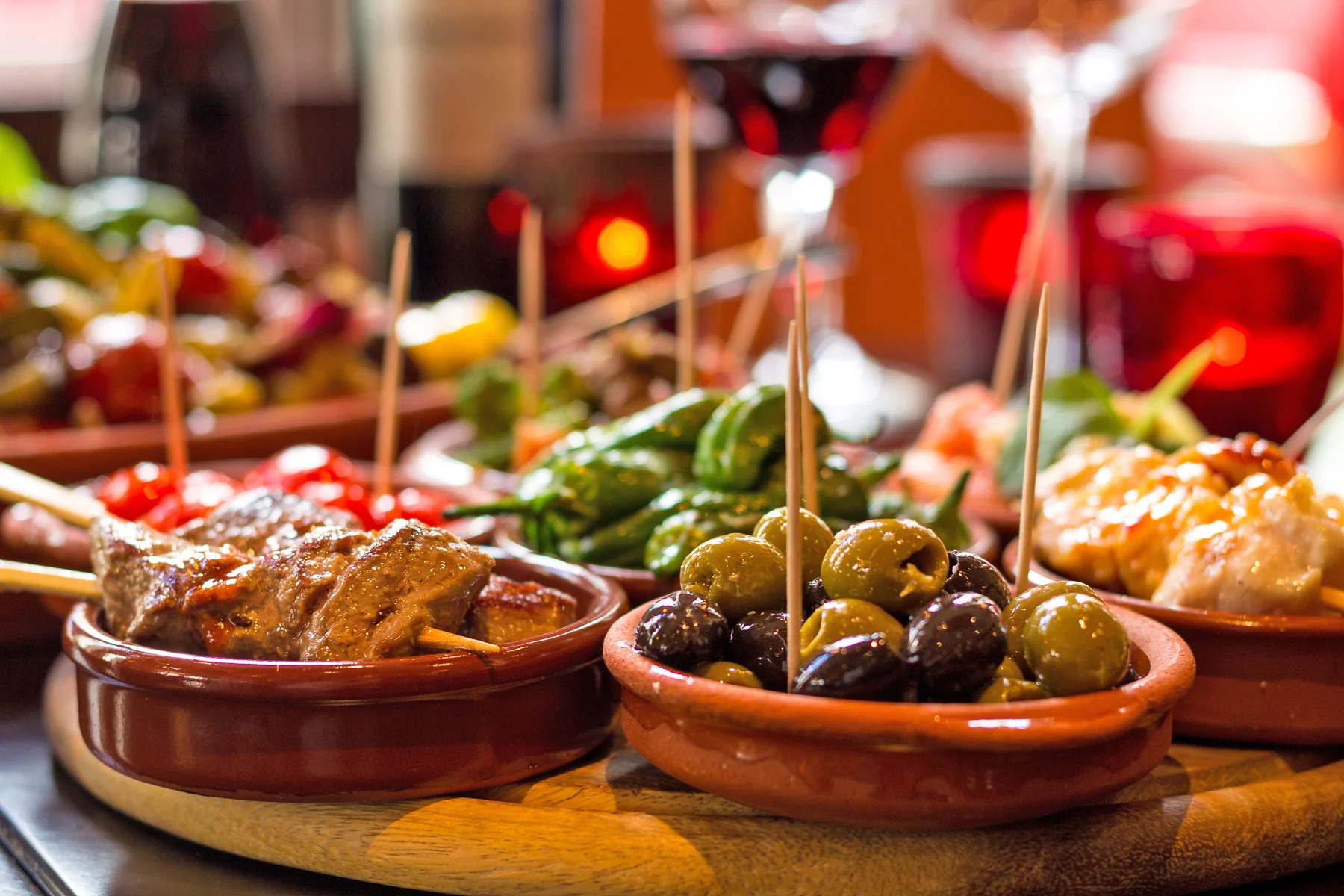
Typically, tapas are small portions of food that are served as a drink companion or aperitif in bars or restaurants. For Spaniards, eating tapas is a social activity centered around catching up with friends or acquaintances over drinks while getting nourishment at the same time. If several rounds of drinks are ordered, however, this can sometimes replace lunch or dinner entirely. Usually, as the number of rounds increases, so does the quality of the items in the tapas.
Tapas can include anything from cold olives, sausage (chorizo), Spanish ham (jamón), fried fish, seafood, and montaditos (slice of baguette with cheese or meat on top), to more complex items. Although there are many varieties of tapas across the country, it is said that it represents the quintessence of Spanish cuisine. For example, in the Basque Country, tapas are called pintxos – which means “pointed stick” or toothpick – as they are usually “spiked” into small pieces of bread.
Special meals in Spain
In Spain, food is a cornerstone that brings families and friends together to share and enjoy traditions. This is particularly the case during the holiday season. Here are some special meals that you might come across while living in the country.
Christmas dinner
There isn’t an established course or dish that people in Spain enjoy at Christmas. In the Castile and Leon region, however, popular Christmas foods include roast lamb (Cordero asado) or roast suckling pig (Cochinillo asado). And when it comes to the sweet side of Christmas, Turrón is the most popular dessert throughout the country. It consists of a nougat typically prepared from nuts, sugar, and honey. Besides this, people like to indulge in a variety of rich confections such as Polvorones (almond cookies), Mantecados (crumble cookies), Mazapán (Marzipan), and chocolate. The sparkling wine Cava is also a popular drink to make a toast.
Epiphany cake
Any true Spanish celebration of Epiphany wouldn’t be complete without Roscón de Reyes on the table. While this oval-shaped cake is traditionally baked for Three Kings Day, you can find it in bakeries in Spain throughout the whole Christmas period. It also comes with hidden surprises inside.

Easter cake
You can enjoy plenty of sweets like Torrijas or Pestiños during the Easter celebrations in Spain. The most popular traditional Easter cake is probably Mona de Pascua. You can find different variations of this dessert – which is round or donut-shaped – across the country. It can be topped with hard-boiled eggs or decorated with chocolate eggs or amusing, colorful figurines. It is a common custom for godparents to give this treat to their godchildren on Easter Monday.
Popular ingredients in Spain
Spain is one of the world’s leading countries when it comes to organic farming. It is also the biggest producer in the EU with the second-largest area under cultivation. It comes as no surprise then, that the country is famous for its abundance of locally grown crops. Due to its location and climate, it also has a rich variety of fish, seafood, and meat products.
Here are some of the key ingredients that you are likely to come across in Spanish kitchens:
Olive oil
A fundamental component of the Mediterranean diet and a must-have product in every Spanish kitchen is olive oil (aceite de oliva). The most popular contemporary writer from Spain, Arturo Pérez-Reverte, wrote in one of his weekly essays in XL Semanal magazine that olive oil not only forms part of the Spanish dining table, but also the Spanish nation’s culture and collective memory.

Indeed, there is a long history of olive oil cultivation in Spain that dates back 3,000 years. Today, Spain is the world leader in the production and export of the golden juice of the olive fruit. In fact, it is estimated that more than 40% of the total olive oil production in the world comes from Spain; mainly from Andalusia. Needless to say, olive oil is omnipresent in Spanish cuisine. It is used for salad dressings, tenderizing meats, cooking, barbecuing, baking, marinating, broiling, sautéing, frying, and braising.
Meat
Meat is an integral component of the Mediterranean diet. Therefore, it is no surprise that Spain has a high level of meat consumption per capita – more than 100 kilograms per year – which is higher than the EU average of 82.6 kilograms.
Popular types of fresh meat in Spain include:
- chicken (carne de pollo)
- pork (carne de cerdo)
- beef (carne de vacuno)
- sheep/goat (carne de ovino/caprino)
- rabbit (carne de conejo)
Jamón
Cured ham (jamón) is the main product of the Spanish meat industry that is greatly appreciated worldwide. Spain has a centuries-long tradition of curing hams and other meat products (charcutería). In fact, each year, the country produced more than 40 million hams.
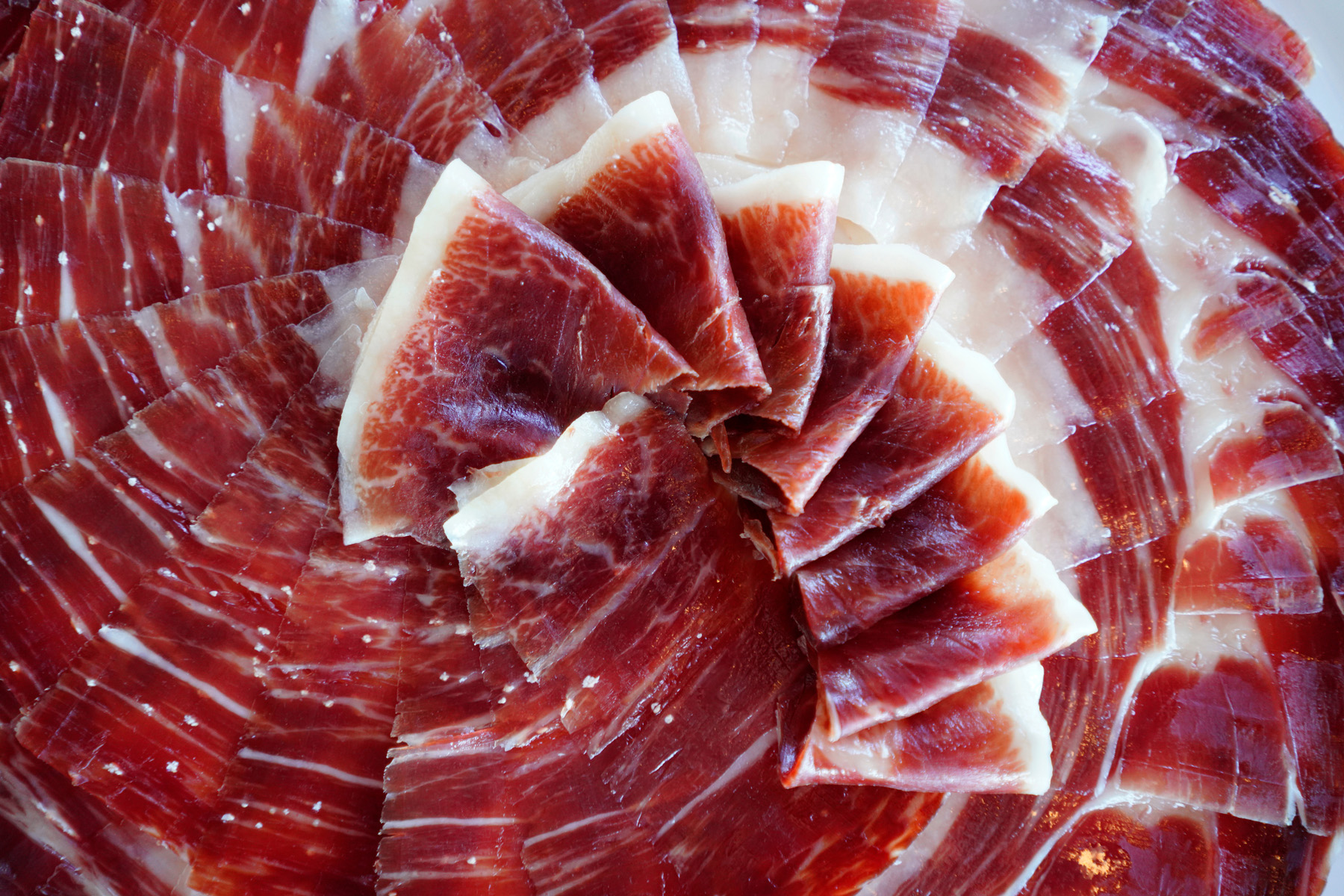
While jamón serrano, which is made from white pigs, is the most common ham in Spanish households, jamón ibérico is an ultimate delicacy. This is the highest quality of all cured hams that are produced in Spain. The finest type of jamón ibérico is Jamón 100% Ibérico de Bellota (pictured) which is only produced in Spain from acorn-fed pure-bred Black Iberian pigs that roam freely in the mountainous area of western Spain. The curing process can last up to 36 months.
Chorizo
Another signature Spanish meat product that is globally recognized is chorizo. Spanish chorizo is a type of sausage (embutido) that is made from coarsely chopped pork and pork fat. Chorizo includes pimentón (smoked paprika), which gives it a red color. There are a huge number of different regional variants of chorizo. Many Spanish recipes call for meat, including pollo al ajillo (garlic chicken), cochinillo asado (roast suckling pig), and fabada (bean stew with chorizo).
Fish
With almost 8,000 kilometers of coastline and a ravenous appetite for fish, Spain is one of the largest markets for seafood in the world. In fact, it has the second-highest annual consumption of fish and seafood per capita in the EU, after Portugal. According to a report published by the wholesale chain management company Mercasa, popular types of fish in Spanish households include:
- hake (merluza) and whiting (pescadilla)
- sardine (sardina) and anchovy (boquerón)
- tuna (atún) and bonito (bonito)
- fresh trout (trucha fresca)
- sole (lenguado)
- cod (bacalao)

Spaniards consume fish in many ways including fresh, processed, frozen, in brine, and also raw. And if you live in the country, you will have a great opportunity to try various types of seafood, including:
- prawns – gambas
- shrimps – langostinos
- squids – calamares
- octopus – pulpo
- mussels – mejillones
- clams – almejas
- cockles – berberechos
Here are some iconic fish and seafood dishes in Spanish cuisine:
- Gambas al ajillo (garlic prawns) – a classic Spanish tapa
- Pulpo a la Gallega – a Galician-style octopus prepared with sweet or spicy paprika
- Bacalao al pil pil – a traditional dish in the Basque cuisine that includes salted cod with pil-pil sauce
Vegetables
You can enjoy a wide variety of fresh, seasonal vegetables throughout Spain. According to FEPEX (The Spanish Federation of Associations of Producers and Exporters of Fruits, Vegetables, Flowers, and Live Plants), popular types of vegetables in Spain include:
- tomato – tomate
- cucumber – pepino
- aubergine – berenjena
- zucchini – calabacín
- pepper – pimiento
- cabbages – coles
- broccoli – brócoli
- onion – cebolla
- carrot – zanahoria
- garlic – ajo

If you are looking for flavorsome dishes that incorporate vegetables, you should definitely try pisto (the Spanish version of ratatouille), tortilla de patatas / tortilla española (Spanish potato omelet), or croquetas (croquettes). In Andalusia, popular vegetable soups include classic gazpacho or ajo blanco (also named white gazpacho).
Fruit
In Europe, Spain is one of the leaders in the fruit sector. The country’s most popular exports include mandarins, oranges, lemons, and grapefruit. When it comes to family preferences, Spanish households tend to enjoy the following fruits:
- orange – naranja
- lemon – limón
- tangerine – mandarina
- grapefruit – pomelo
- banana – plátano
- kiwi – kiwi
- avocado – aguacate
- pineapple – piña
- custard apple – chirimoya
- grape – uva
- apple – manzana
- pear – pera
Spanish cuisine features many desserts that include fruits. For example, frutas de Aragón consists of sugar-candied fruits dipped in chocolate. And in Valencia, you can try Arrop i tallaetes which includes different pieces of fruit (pumpkin, quince, lemons, oranges, figs, and plums) dipped in a sweet, intense syrup made from dark grape must.
Carbohydrates
Bread (pan) is another core component of the Spanish diet and accompanies almost every meal throughout the day. According to data provided by the Spanish Ministry of Agriculture, Fisheries and Food, the average Spaniard ate 31,87 kilograms of bread each year in 2018. Generally speaking, they also prefer to pour olive oil on top of bread, rather than butter. Bread is also a significant ingredient of Spanish classic dishes such as ajo blanco (chilled garlic soup) or pan con tomate (bread with tomato).

Across the country, bread and rolls come in different shapes, sizes, and names – depending on the region. For example, molletes de Antequera (soft white round bread originally from Antequera) and pan cateto (traditional rural bread) are classic varieties in Andalusia.
Of course, when it comes to rice dishes in Spain, paella reigns supreme. While you may encounter many versions of this, the most recommended is the traditional Valencian paella which contains rabbit, chicken, garrofó (local haricot bean), and olive oil. The characteristic feature of this popular rice dish is its bright yellow color, which is created by adding saffron.
Generally speaking, Spanish cuisine features a wide variety of rice dishes. In fact, Spain is the EU’s second-largest rice producer after Italy. Rice is also an essential component of the classic Spanish dessert arroz con leche (rice pudding). Fideuà, meanwhile, is a traditional Valencian dish that is very similar to paella but made with pasta noodles instead of rice.
Cheese and dairy products
Cheese is another significant component of Spanish cuisine. You can find more than 150 varieties of cheeses in Spain. It is used to prepare many types of dishes including desserts, salads, and tapas. It can also be served as a snack. You have probably heard of manchego – the true star of Spanish cheeses. This world-known, iconic cheese, is made from local sheep milk and accounts for more than a third of Spain’s traditional cheese production. It is famous for its sophisticated flavor which is buttery, nutty, and slightly acidic. Depending on the aging period, it can also be sweet.

Here are some other popular cheeses from Spain:
- Idiazabal – a cheese made from raw sheep’s milk in the Basque and Navarra regions. It has a distinctive smoky flavor.
- Mahón cheese – a flagship product from Menorca, made from raw cow’s milk. Depending on its aging, it can have an intensely fruity flavor.
- Torta del Casar – a cheese made from raw sheep’s milk in Extremadura. It has an intense aroma, creamy texture, and slightly bitter taste.
Spices
One of the key principles of Spanish cuisine is simplicity. Many Spanish dishes have a small number of ingredients, but when it comes to the final result, you can expect flavorful meals that aren’t usually spicy. This is largely because Spanish cooks use herbs and spices in moderation. That said, Spanish paprika or pimentón is a spice that features in countless recipes including Galician octopus, paella, patatas bravas, chorizo, sauces, stews, and even ice cream!
Here are some other popular herbs and spices that are used in Spanish cuisine:
- pepper – pimienta
- saffron – azafrán
- parsley – perejil
- paprika – pimentón
- rosemary – romero
- bay leaves – hojas de laurel
- oregano – orégano
- thyme – tomillo
- basil – albahaca
Sauces
Sauces are another key element in Spanish cuisine that enrich dishes and enhance the flavor of meals. They can be used as a cooking base for traditional dishes, as a side to the main course, or served as a dip for vegetables or baguette bread. Almost every region of Spain has its own signature sauce that is made from locally grown ingredients.
Here are the most popular sauces on Spanish dining tables:
- Romesco sauce – a traditional Catalan sauce made from roasted tomatoes, ñora peppers, garlic, olive oil, and toasted almonds, all mashed into a paste. Romesco sauce is served with poultry, fish, meat, or vegetables.
- Aioli, allioli, or aïoli – a sauce that originated in the northwestern Mediterranean. Its basic ingredients include garlic, salt, and olive oil. It is served with fish, seafood, chicken, pork, or vegetables. It complements dishes such as Arròs a banda, Arròs negre, fideuà and also croquetas de jamón or patatas bravas.
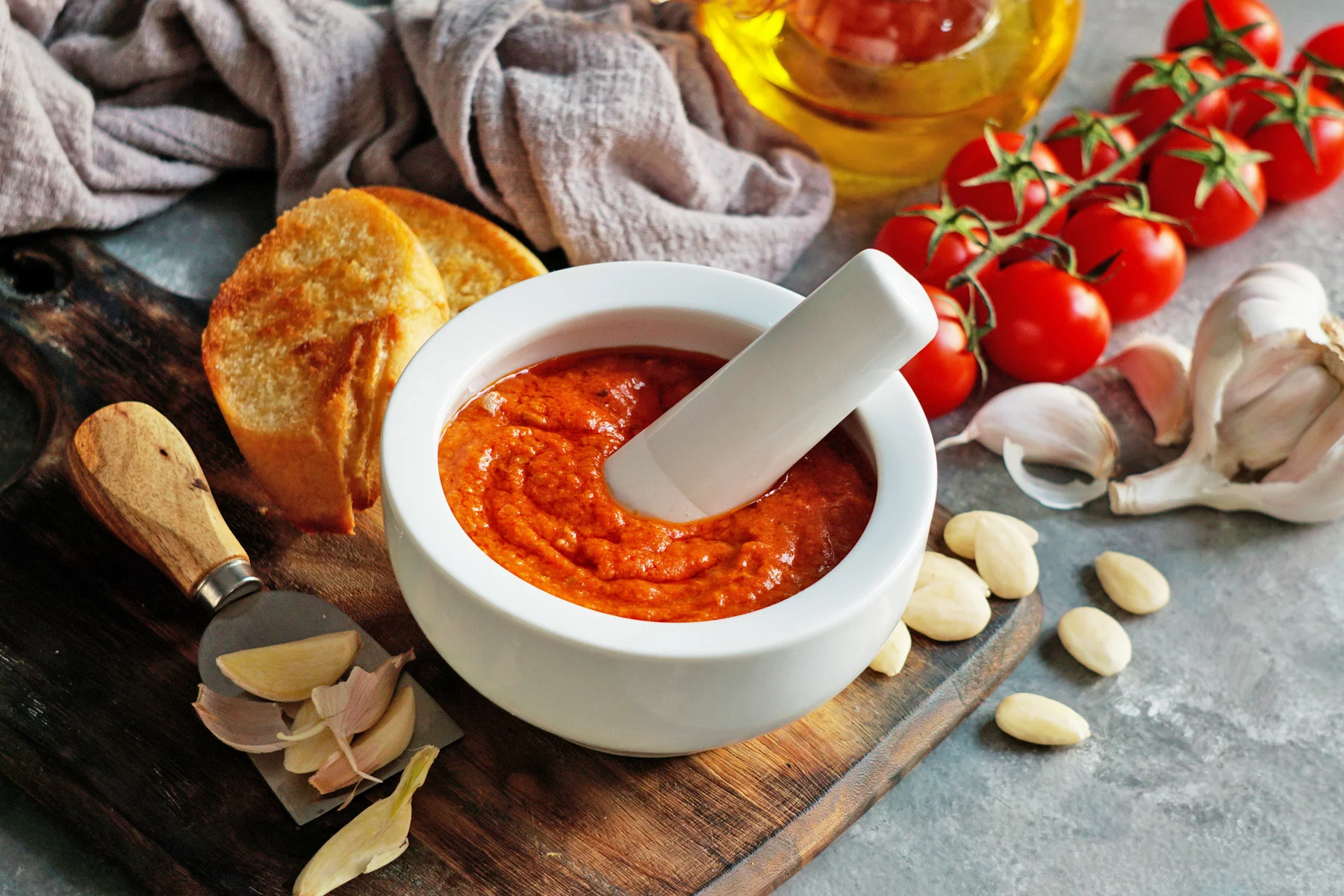
- Sofrito – a traditional Spanish sauce made from tomatoes, onions, garlic, and pepper. It forms the cooking base of many Spanish dishes including menestra (a vegetable dish containing green beans, peas, and artichokes). It can be used as filling for empanadas or as a base for other sauces, soups, or stews.
- Mojo – this is the generic term for the various types of spicy local sauces from the Canary Islands. These vary in spiciness and are prepared with olive oil, garlic, paprika (pimentón), cumin or coriander, and local pepper varieties. Mojo can be served with fresh bread rolls at the beginning of a meal or accompany dishes like patatas arrugadas (Spanish wrinkled potatoes). The most known varieties are Mojo Picon (also named Mojo Rojo or Mojo Bravo) which are made with red pepper, and Mojo verde, made with green pepper.
Famous dishes in Spain
If you want to try some authentic Spanish dishes, then you can always follow these simple recipes and prepare some at home. You might also want to try some other typical Spanish dishes following the instructions below:
Pan con tomato (Catalan: pa amb tomàquet)
Spanish tomato bread is essentially a slice of toasted bread rubbed with a halved garlic clove and grated tomato. You simply spread the grated ripe tomato onto the toast, drizzle it with olive oil, and add a bit of salt.
Ajo blanco (garlic soup)
This delicious Spanish garlic soup is a great crowd-pleaser. To make it, combine almonds, bread, and garlic in a food processer. Add one liter of water and blend until the mixture becomes smooth. With the motor still running, add the vinegar and olive oil to the mixture and season it with a bit of salt. Keep blending.
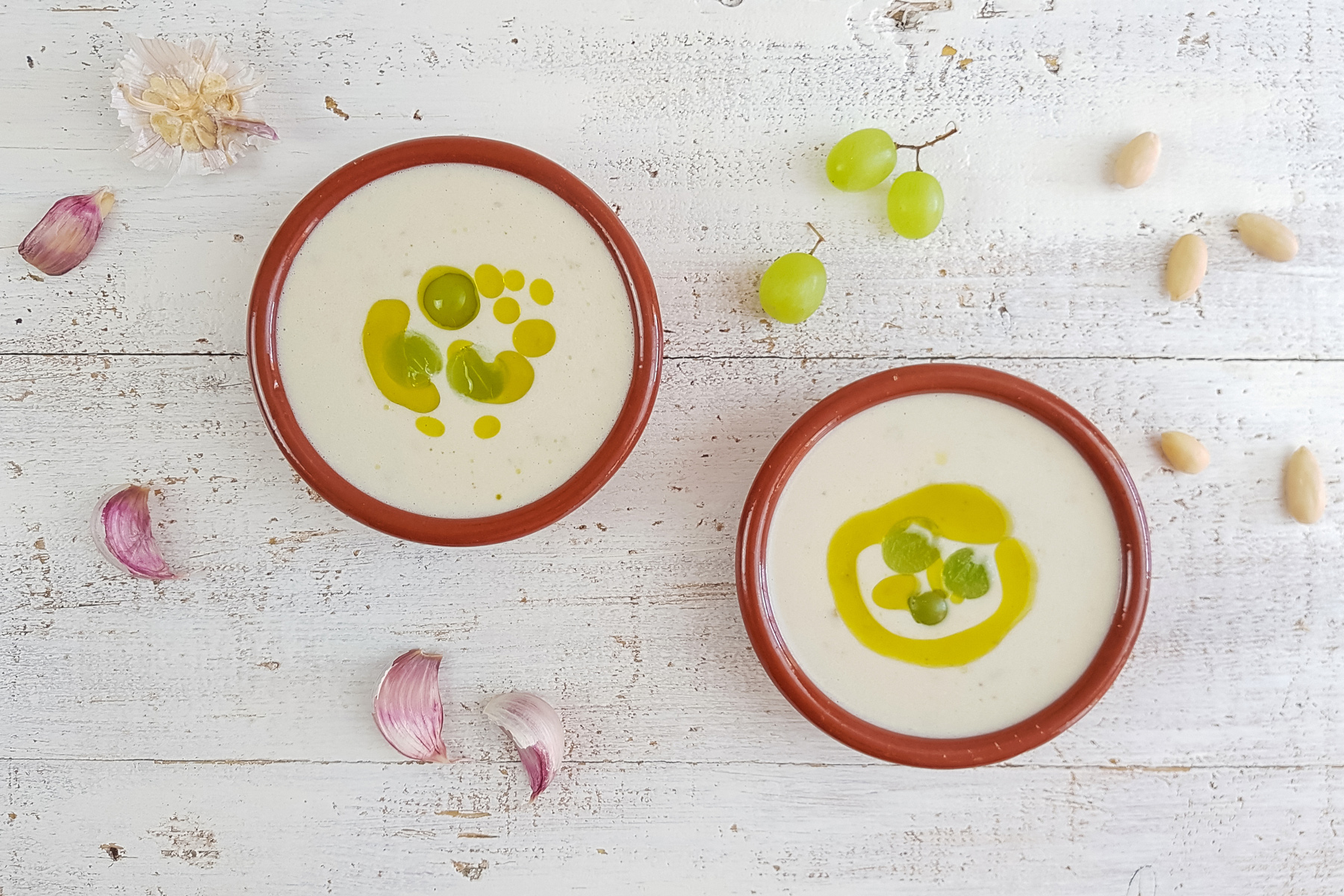
Once the mixture gets the desired consistency, pour it into a bowl. Cover the soup and allow it to chill in a fridge for at least two hours. Pour the soup into small bowls, top it with toasted almonds and halved green grapes, and drizzle it with olive oil.
Ensalada mixta
Ensalada mixta is basically a mixture of lettuce, tomato, carrot, and tuna. To complete this simple salad, decorate it with slices of hard-boiled egg and drizzle it with vinegar and olive oil.
Famous desserts in Spain
Like many dishes in Spanish cuisine, confections also have a significant Moorish influence; especially those made with almonds or honey, mazapán (marzipan), and turrón (Spanish nougat). The Moors helped develop many Spanish desserts and other sweets by introducing sugarcane into the country during the early Middle Ages.

Interestingly, many centuries-old recipes for cakes, cookies, and other confections were developed in convents; for instance, Yemas de Santa Teresa (egg-yolk pastry) and Bollitos de Santa Inés (sesame rolls). Across the country, cloistered nuns also sell confections as a form of income.
Here are some other popular desserts in Spanish cuisine:
- Flan – a custard-based dessert made from eggs, milk, sugar, and vanilla extract with caramel sauce on top.
- Tarta de Santiago – an almond cake (tart) originally from Galicia. This cake usually has powdered sugar in the shape of the Cross of St. James (also known as the Cruz de Santiago) on top.
- Crema Catalana (Catalan cream) – also known as Crema de Sant Josep, this flagship dessert from Catalonia contains sugar, milk, and egg yolks.
Regional differences in Spanish cuisine
There is an old Spanish proverb about the diverse cooking methods throughout the country. “In the north, you stew, in the center, you roast, and in the south, you fry”. Although this is a simplification, to a certain degree it reflects Spain’s regional culinary differences.
Green Spain
Green Spain (España verde) refers to the northern region of the country that stretches along the Atlantic coast. Generally speaking, the cuisine of Green Spain features a wide variety of seafood, sauces, and meats.

The perfect destination for every cheese lover will be The Principality of Asturias, also called “the land of cheeses” (el país de los quesos). The cuisine of Asturias is famous throughout Spain for its impressive, wide range of cheeses; there are more than 50 varieties! The star of the show is cabrales (queso de Cabrales), a blue cheese of intense aroma, made from unpasteurized cow’s milk or a mixture of two or three kinds of milk (cow, goat, and sheep).
Galicia, meanwhile, is known for its 300 gastronomic fiestas that are held there every year. During these celebrations, you can try a wide range of sea, farm, and country products. The local flagship dish is empanada Gallega, a pie stuffed with meat or fish, seafood, and vegetables.
Typical dishes in Cantabria include cocido montañés, which is a bean stew, and cordero al chilindrón, a lamb stew and representative dish of the regional cuisine of Navarre.
Basque Country
For anyone seeking an unforgettable culinary experience, a visit to Basque country is an absolute must. The region takes pride in its strong representation on The World’s 50 Best Restaurants list (2019 edition) which includes five restaurants from this region.
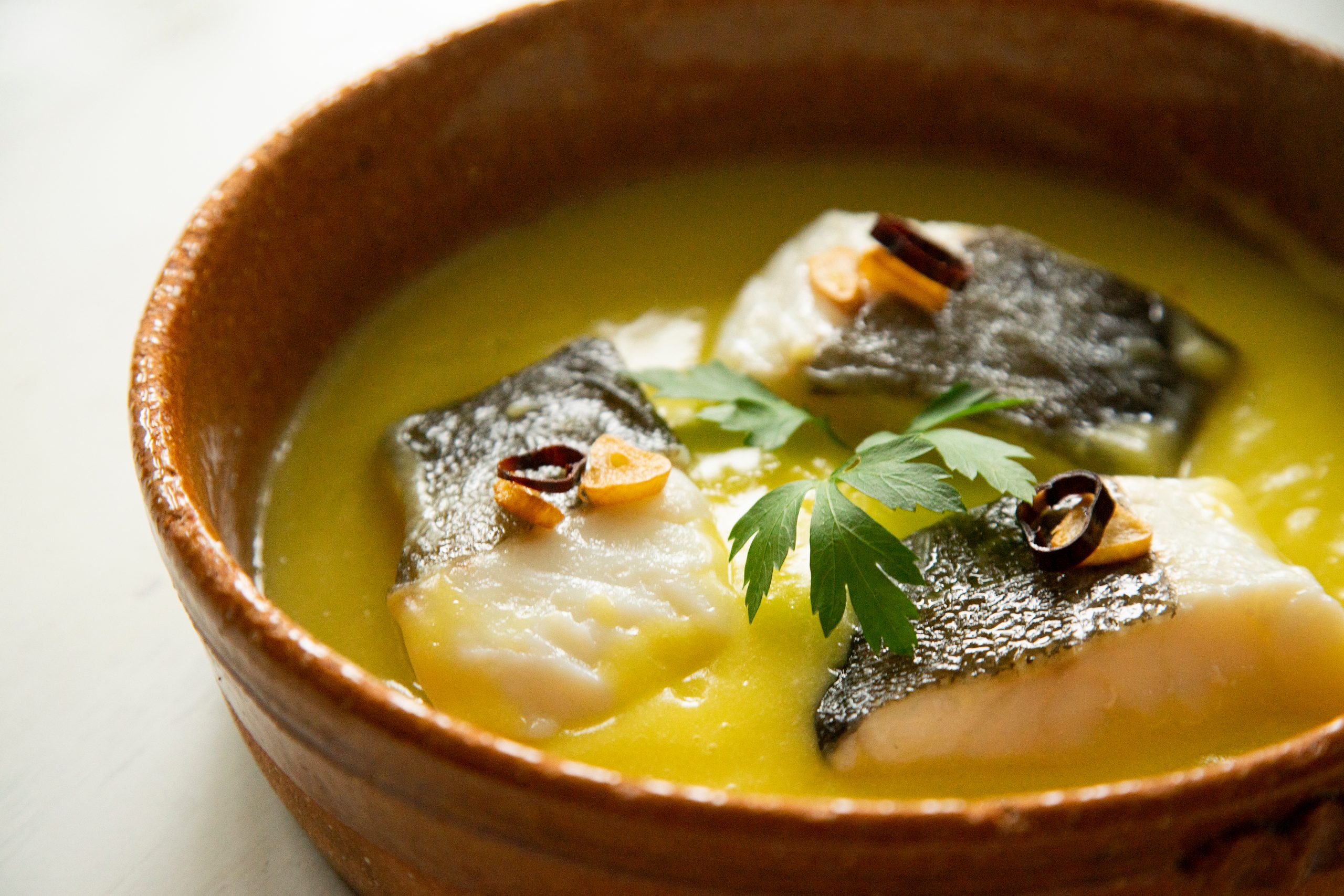
Basque chefs have often been praised by international food critics for their cutting-edge cooking techniques, sophisticated flavor combinations, high-quality ingredients, and cuisine that is deeply rooted in traditions. Cod is an essential component of many Basque dishes, for example, bacalao al pil-pil (salted cod) and tortilla de bacalao (salt cod omelet).
Among the local classic dishes that every visitor should try are marmitako (tuna stew with vegetables) and pisto a la Bilbaína (Bilbao ratatouille). Talo is also a very common cornbread in Basque Country.
Catalonia
Another region of Spain that is home to chefs of international fame and acclaim is Catalonia. In the classic book about Catalonia’s gastronomy, Llibre de la cuina catalana (or Book of Catalan Cuisine), author Ferrán Agulló observes that, just like language, food is a sign of Catalonia’s identity. He writes, “Catalonia does have [a cuisine], and it has something else besides: a great power to assimilate the dishes of other cuisines, like the French and the Italian, making them its own and modifying them according to its own style and taste”.

Catalonia’s geographical diversity is clearly reflected in its cuisine which features dishes described as mar y montaña (or mar i muntanya in Catalan). These are essentially surf and turf which combine seafood and meat. Some popular dishes are mandonguilles amb sípia (meatballs with cuttlefish), arròs mar i muntanya (rice with meat and seafood), pollastre amb llagosta (chicken with lobster), and pollastre amb escarmalans (chicken with crayfish).
Whenever you are in Catalonia, you might also like to sample the following dishes:
- Suquet de peix – a fish stew with potatoes
- Esqueixada – a salt cod salad with vegetables (tomatoes and onion)
- Fricandó – a beef stew with mushrooms
- Escudella – a stew-soup containing various types of meat and vegetables
Valencia
The dominant component of cuisine in the Valencian region is rice. After all, it is home to the iconic paella, which dates back to the 15th century. Other popular rice-based dishes in Valencia include arròs a banda (rice cooked in fish stock) or arròs negre (rice with cuttlefish or squid).
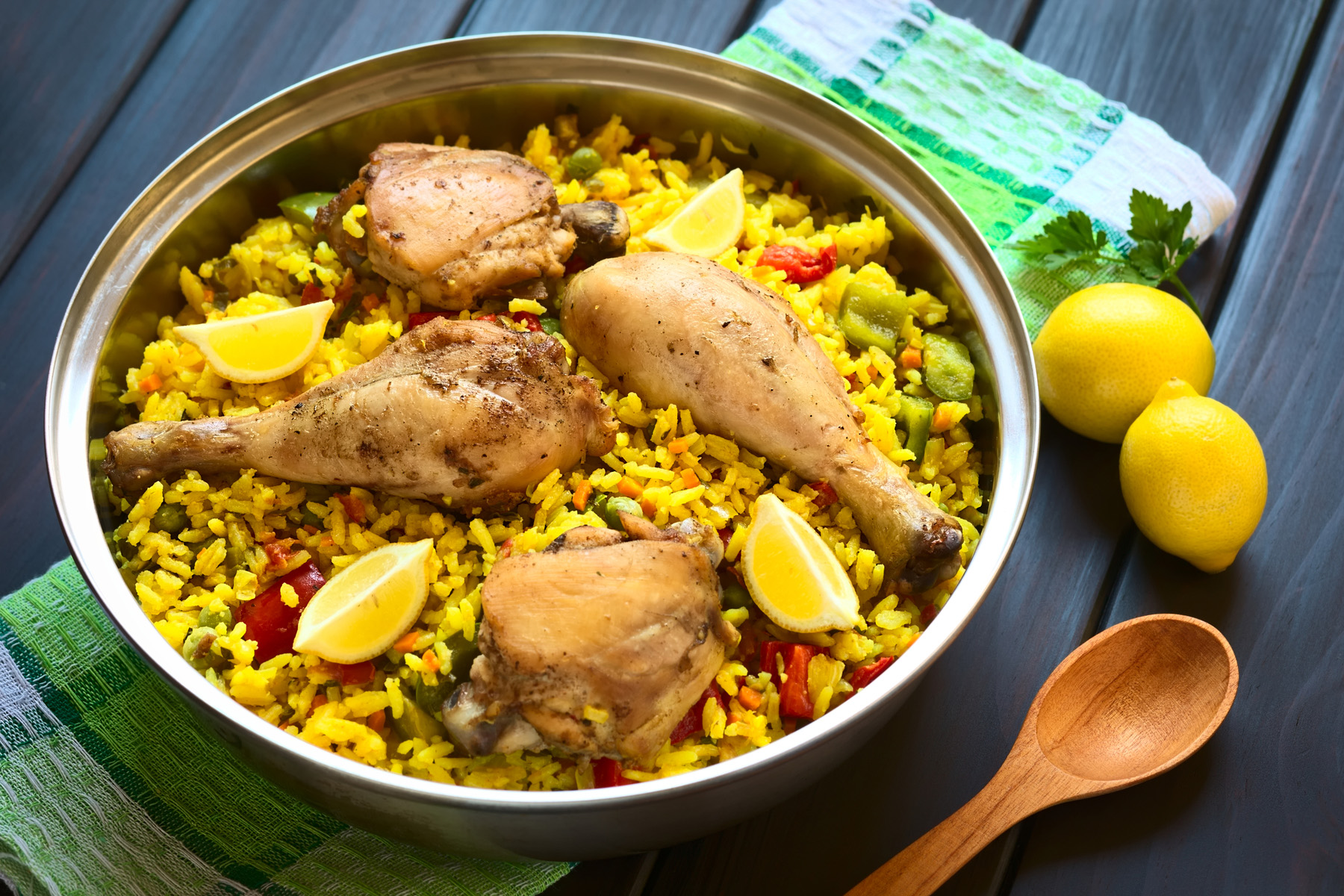
Valencian cuisine also includes a wide range of ollas (soups and stews) which are prepared from meat and the stock of pulses. An example of this is olla de recapte (consisting of meat and vegetables) and olla de la plana (prepared with seasonal vegetables).
A significant part of the Valencian diet is seafood. You can sample various types of fish at local restaurants, including spotted flounder, whiting, hake, sea bass, conger, anglerfish, and red mullet. Valencian cuisine also features a rich variety of desserts such as turrón (nougat), arnadí (cake with sweet potato and pumpkin), and pastissets (pastry with sweet potato filling).
Spain of the Roast
On the culinary map of Spain, three Autonomous Communities – Castile and León, Extremadura, and Castile La Mancha – are collectively named España del Asado (Spain of the Roast). This is due to the fact that the cuisine of these regions is dominated by roasted meat and fish (asado). You can enjoy an extensive range of meat foods as well as different kinds of garlic soups here.
The cuisine of Castile and León centers on roast meats and stews. Among the local specialties are roast lamb, suckling pig, sausages (embutidos), cured hams, and fish or meat pastries (empanadas).

The cuisine of Extremadura is known for its variety of pork products such as morcilla patatera (sausage containing pork meat, fat, and mashed potato) or morcilla de calabaza (sausage made with pumpkin). A popular dish is cachuela which contains pork liver pâté seasoned with garlic and paprika. You will be delighted with the wide range of cheeses you can sample in Extremadura. These include sheep milk cheeses (torta del Casar and torta de la Serena) and goat milk cheeses (Ibores and quesaílla cheese).
Cheese is also an important part of the cuisine in La Mancha. The most famous product is the cheese, queso manchego. The main culinary specialties of the region include pisto manchego (vegetable stew) and asadillo manchego (roasted red peppers). La Mancha is also one of the largest wine-producing areas in the world. So you will never be short of incredible wines to pair with your food.
Andalusia
There is a wide variety of fish and seafood in Andalusia, including the following:
- sole
- sea bass
- baby hake
- sea bream
- red mullet
- sardines
- prawns
- anchovies
- baby squid
- cuttlefish
- murex
- wedge sole
- wedge shell clams
- white shrimp
- bluefin or red tuna (atún rojo) – a highly prized catch
You will also find an extensive range of meat products (cured hams and sausages) and meat dishes (game stews and lamb stews) in Andalusia.
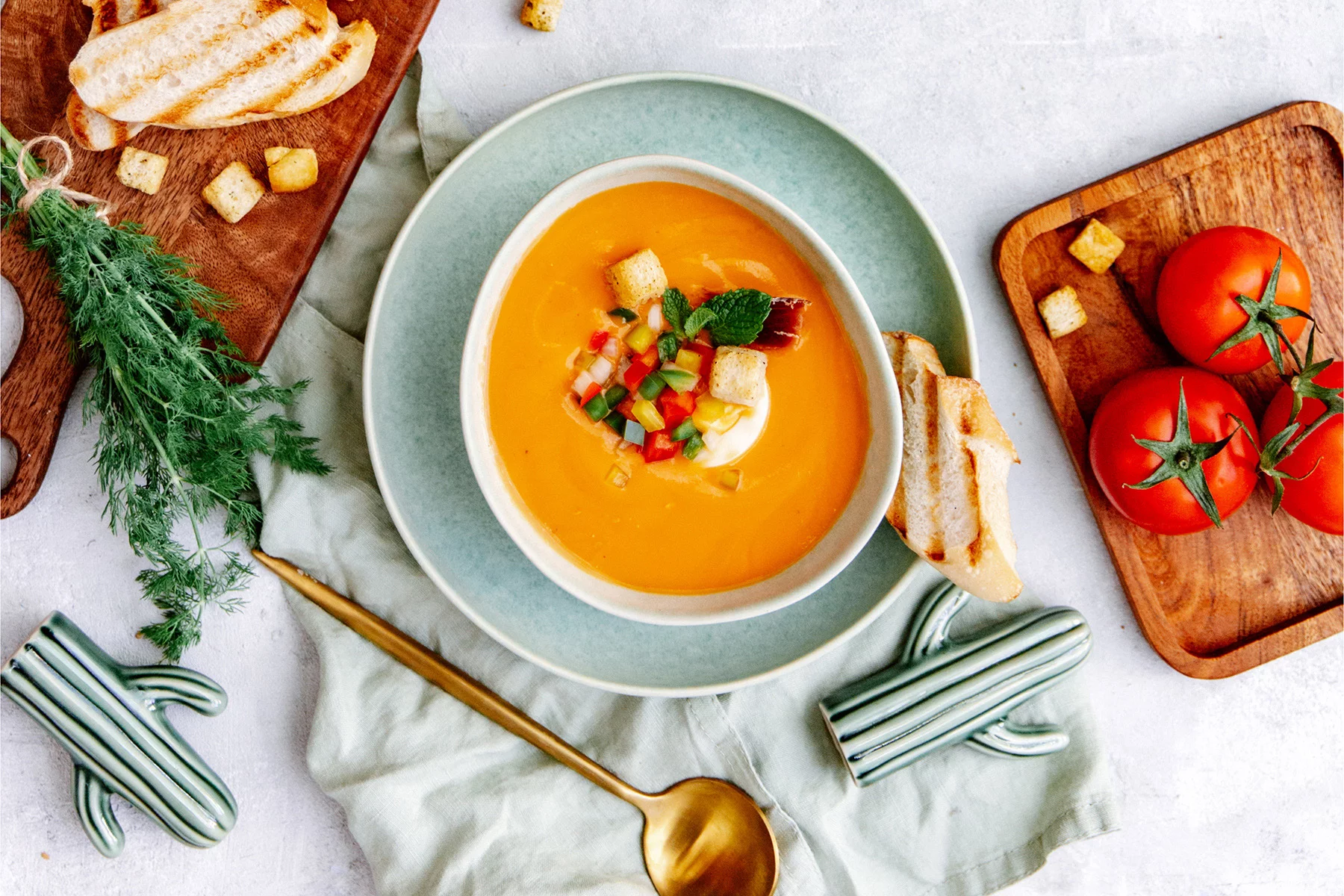
If you ever visit the region, you might also want to try some of the local soups. Here are some refreshing cold soups that are particularly worth trying during hot weather:
- Gazpacho – a signature Andalusian dish consisting of liquified raw vegetables in a tomato base
- Salmorejo – a soup with a creamy texture, prepared from tomatoes, bread, garlic, and oil
- Ajo blanco – also sometimes named white gazpacho, this cold soup is made from garlic, bread, almonds, water, and olive oil
In Andalusian cuisine, the Moorish influences are particularly evident in desserts and pastries including pestiños (honey-glazed pastries), polvorones, and amarguillos (almond cookies).
Useful resources
- BBC – discover the real reason why Spaniards eat late
- CNN – read an article on 14 Spanish dishes you should try – from churros to jamón
- Foods Wines from Spain – discover news and features about Spanish food products and Spanish wines
- Spanish Sabores – find more local recipes from Spain




